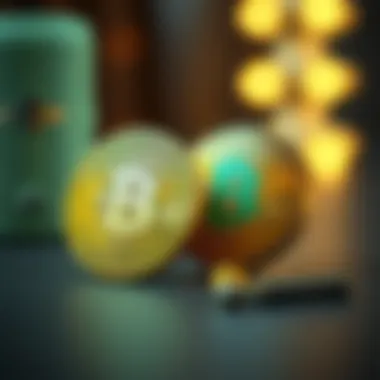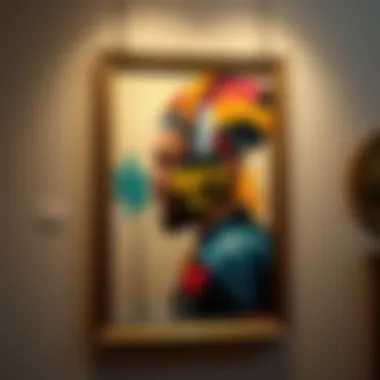Physical Assets and NFTs: A New Era of Ownership


Intro
In today's fast-evolving digital landscape, the notion of ownership is witnessing unprecedented changes. While once it was firmly rooted to the physical domain, the advent of Non-Fungible Tokens (NFTs) has thrown the door wide open, allowing tangible assets to intertwine with digital tokens in remarkable ways. Picture this: a piece of art hanging on your wall, paired with an NFT that verifies its authenticity and ownership. Thus, the intersection of physical assets and NFTs is not just a fanciful notion—it’s shaping how we perceive value and ownership in the 21st century.
Physical NFTs are a burgeoning area of interest that connects tangible items, like real estate or collectibles, with the vast universes of blockchain and digital assets. As we peel back the layers on this concept, it becomes evident that understanding the implications, potential applications, and the challenges that come with it is vital for various stakeholders, including investors, tech enthusiasts, and academics alike.
This article aims to provide a thorough exploration of how physical NFTs can transform traditional industries. As we navigate through current market insights, the latest blockchain innovations, and the implications of this technological shift, a clearer picture is likely to emerge. Only by acknowledging the potential and pitfalls of this intersection can we hope to maneuver successfully through this complex landscape.
Market Insights
To grasp the evolution of physical NFTs, we must first examine the prevailing trends within cryptocurrency markets and identify the key indicators that can forecast their growth.
Current Trends in Cryptocurrency Markets
The world of cryptocurrencies is vast and ever-changing. Yet, certain trends have become evident in recent months.
- Increased Institutional Investment: Major corporations are no longer shying away from cryptocurrencies. Their investments are creating a more stable environment, prompting others to dive deeper.
- Integration of NFTs in Various Sectors: From art to gaming and music, NFTs are making their mark. High-profile auctions like the sale of digital art for over $69 million at Christie’s have brought mainstream attention.
- Regulatory Scrutiny: With competition among new financial technologies rising, regulators are stepping in. Countries are working to create a framework for cryptocurrencies and NFTs, ensuring consumer protection while fostering innovation.
Key Indicators for Market Analysis
Evaluating the future of physical NFTs demands a look at certain indicators:
- Blockchain Transactions: An increase in blockchain transactions is a good sign of growing interest and market activity.
- User Engagement: The rising number of active users in NFT marketplaces can indicate both demand and the potential longevity of the market.
- Partnerships and Collaborations: Successful partnerships between traditional industries and blockchain companies can signal a fruitful road ahead for physical NFTs.
"The future of property ownership and investment could very well hinge on the integration of NFT technology, creating new opportunities but also significant hurdles that the industry will need to navigate."
Blockchain Innovations
Understanding the underlying technology propelling physical NFTs is crucial. The blockchain serves not just as a ledger but as a transformative tool for transactions.
Emerging Blockchain Technologies
Recent innovations in blockchain technology are influencing how physical assets are tokenized. Key advancements include:
- Layer-2 Scaling Solutions: These solutions enhance transaction speeds and lower costs, vital for an effective marketplace for physical NFTs.
- Interoperable Standards: Protocols that allow different blockchain networks to communicate can expand the market and democratize asset ownership.
- Decentralized Finance (DeFi): The rise of DeFi platforms may serve as a catalyst for embedding physical NFTs within broader financial ecosystems.
Real-world Applications of Blockchain
The practical uses of blockchain technology extend beyond just cryptocurrencies. Current applications that bridge the physical and digital realms include:
- Tokenization of Real Estate: Properties can be broken down into tradable digital shares, granting more people access to investments.
- Art Authentication: Artists are using NFTs not just for sales but to prove their work's authenticity, an aspect crucial in traditional markets.
- Asset Management: Blockchain provides a transparent record of ownership and transaction history, facilitating easier asset management.
As the discourse around physical NFTs and the technology that fuels them expands, it becomes increasingly critical to embrace both the opportunities and challenges ahead. This exploration will inform how stakeholders can best align with future developments.
Prolusion
The blend of physical assets and NFTs offers a fresh perspective on ownership and value in our digital and tangible world. With the right tools, this intersection opens avenues, not just for artists, collectors, or real estate moguls but for anyone interested in how we define what is ours. As we stand amidst a technological renaissance, understanding how these two realms intertwine sheds light on a new frontier of asset management and investment.
Many might see NFTs as merely digital items with pixel-perfect appeal. However, the landscape is expanding, and physical NFTs challenge the notion of what can be tokenized. They represent a transformative approach to ownership that weaves real-world commodities into the intricate tapestry of blockchain technology. This is no passing interaction; it can reshape how markets operate and challenge traditional perceptions of asset security and authenticity.
As we embark on this exploration, consider the benefits we gain by recognizing the potential of physical NFTs:


- Enhanced Authenticity: Digital verification can bolster trust in tangible goods.
- Greater Market Access: A broader spectrum of collectibles can be bought, sold, or traded.
- New Revenue Channels: Artists and sellers can find novel ways to monetize their creations.
However, with potential comes consideration. Delving into the heart of this topic necessitates a look at the underlying mechanics of NFTs themselves and how they contrast against physical assets. In the sections to follow, we will break down these foundational elements, enabling you to grasp fully the significance of merging the tangible and digital in today’s evolving market.
Defining Physical NFTs
Physical NFTs represent a unique and evolving intersection between tangible assets and blockchain technology. The significance of defining these digital tokens cannot be overstated, as they pave the way for innovation in ownership, provenance, and asset management. As the market for non-fungible tokens swells, understanding what constitutes a physical NFT is crucial for investors, tech enthusiasts, and academics. This section will highlight the intrinsic concepts, characteristics, and the technology that supports the functionality of physical NFTs.
Concept and Characteristics
At the core, a physical NFT is a digital certificate linked to a real-world item—be it art, real estate, or any tangible asset. Rather than simply being a digital image or file, it embodies the actual ownership of a physical piece. This digital ownership can manifest as a unique code or token stored on a blockchain, ensuring authenticity and transferring ownership securely.
Characteristics of physical NFTs include:
- Uniqueness: Each physical NFT is distinct, much like traditional works of art where no two pieces can be exactly alike.
- Traceability: Ownership history is recorded on the blockchain, making it easy to track provenance and verify authenticity.
- Tokenization: Physical items are 'tokenized', allowing them to be traded, bought, or sold in a digital marketplace seamlessly.
The intersection of these traits not only enhances asset security but also democratizes access to art and collectibles, allowing ownership to be shared or fractionalized among individuals.
Technology Behind Physical NFTs
Understanding the technology that propels physical NFTs adds another dimension to comprehending their importance. At the base level, blockchain serves as the backbone, providing a decentralized ledger that maintains records of ownership and transaction history. Not only does this decentralized approach foster trust among users, but it also renders the system resistant to tampering and fraud.
In addition to blockchain, several key technologies come into play:
- Smart Contracts: These self-executing contracts are programmed to enforce the terms of an agreement when predetermined conditions are met. In the realm of physical NFTs, they can automatically execute ownership transfers upon purchase.
- QR Codes: Sometimes, physical NFTs are integrated with QR codes or NFC chips to connect the physical item with its digital counterpart, enabling easy verification and access.
- Augmented Reality (AR): Cutting-edge technology allows users to view and interact with NFTs in a real-world context, enhancing the overall engagement and experience.
Applications of Physical NFTs
The significance of exploring the applications of physical NFTs cannot be overstated, especially in a world where digital representation increasingly complements tangible ownership. Physical NFTs are poised to revolutionize various sectors by bridging the gap between the physical and digital realms. This fusion not only enhances ownership experiences but also introduces new avenues for investment and consumer engagement. Understanding these applications is vital for investors and innovators keen on leveraging the strengths of blockchain technology while navigating its complexities.
Art and Collectibles
The art world has always been a bastion of traditional ownership, with provenance and authenticity playing pivotal roles in establishing value. Physical NFTs introduce a compelling shift in this paradigm. By linking a digital certificate directly to a physical artwork, artists can ensure that their creations retain their originality even in a rapidly digitizing market. For instance, if an artist like Banksy were to produce a limited series of physical artworks embedded with NFTs, each buyer would receive not just the art, but a verifiable ownership record.
This method serves to not only elevate the artist's profile in an increasingly crowded market but also fosters a more secure investment for collectors. Imagine the leverage this gives to investors. Owning a piece of art with an associated NFT secures their stake in the piece’s ongoing value, opening up possibilities for future sales as the market evolves.
Real Estate Tokenization
Real estate is often viewed as a safe bet, but it’s also brimming with complexities such as legal restrictions and accessibility. Tokenization via physical NFTs could transform this landscape significantly. Each physical property, such as a downtown apartment or suburban home, can have an NFT that represents ownership share, simplified transactions, and public records on blockchain.
This approach breaks down financial barriers; small investors can own fractions of properties instead of competing for full ownership. Imagine a scenario where you own a slice of a luxury high-rise in Manhattan or a quaint cabin in the woods, all tracked via an NFT. The transparency and efficiency offered by this method not only potentializes liquidity in the real estate market but also attracts individuals who might have previously shied away from such investments.
Luxury Goods Authentication
In a market rife with counterfeit products, the luxury goods sector faces unique challenges regarding authenticity and trust. Physical NFTs can play an essential role here. For high-end brands like Louis Vuitton or Rolex, attaching an NFT to their products upon sale serves as a powerful authentication tool. Each piece becomes uniquely identifiable on a blockchain, allowing consumers to verify the legitimacy of their purchases.
This verifiable authenticity can bolster brand loyalty, as customers gain confidence in their investments. When purchasing a luxury watch embedded with an NFT, buyers can rest assured their new timepiece isn’t just a pretty face. Furthermore, resale marketplaces can utilize this technology to provide greater consumer protection, enabling easier tracking of ownership transfer.
Sports Memorabilia
The realm of sports memorabilia has seen both fervent passion and unfortunately, frequent scams. Physical NFTs here offer an exciting breakthrough for fans and collectors alike. Take a game-worn jersey from a renowned player, like Lionel Messi or Serena Williams. By pairing such items with an NFT, the authenticity of each piece can be validated. This represents a landmark shift in how fans invest in their heroes.


Moreover, sports franchises can capitalize on physical NFTs by providing fans with special experiences. For instance, a physical NFT associated with a signed basketball might also grant the owner an invite to an exclusive event with players. This integration can change the game for how merchandise is produced and consumed, creating a new revenue stream for teams and a deeper connection for fans.
"In a world where authenticity is paramount, physical NFTs pave the way for trust and security across various sectors."
Ultimately, by exploring these applications — from art to real estate, and luxury goods to sports memorabilia — we can begin to envision a future where physical NFTs are woven into the fabric of ownership, creating transformative impacts across industries. The adoption may not be immediate, but the groundwork being laid now will set the stage for significant shifts in how we think about property and value.
Market Trends and Insights
Understanding the dynamics of the physical NFTs market is essential for anyone looking to navigate this intriguing intersection of technology and tangible assets. As we explore this territory, it’s crucial to grasp the myriad of factors influencing trends and gathering insights. This section will shed light on how the landscape is evolving and what investors, tech enthusiasts, and academics should keep an eye on.
Current Market Landscape
The current market for physical NFTs is akin to a vast ocean, with waves of innovation colliding with the rocks of skepticism and regulatory considerations. A few key trends have surfaced:
- Emerging Sectors: Several sectors are spearheading the adoption of physical NFTs, most notably art, real estate, and luxury markets. For example, in the art world, galleries are experimenting with tokenized pieces, blending real-world items with digital ownership.
- Integration with Established Platforms: Major platforms like OpenSea and Rarible are rolling out features to support physical NFTs, further legitimizing this market.
- Increased Awareness: As discussions around blockchain gain traction, more people are becoming aware of physical NFTs. This growing interest translates into a slowly widening investor base.
"As industries acknowledge the potential of physical NFTs, the conversation shifts from 'if' to 'how' they will be integrated."
However, the market isn’t flipping on a dime. The challenges of education and awareness remain significant roadblocks. The investors need to navigate both the technical aspects of NFTs and the nuances of physical assets.
Investment Opportunities
Investing in physical NFTs presents a unique set of opportunities that combine the best traits of digital and physical investments:
- Royalty Models: One significant advantage lies in the ability for creators and owners to earn ongoing royalties through smart contracts, which comes in handy in sectors like art and music.
- Diversification: Just as with any asset, adding physical NFTs to an investment portfolio can provide diversification. Unlike stocks, which purely exist in digital form, physical NFTs offer a bridge to tangible and collectible assets.
- New Marketplaces: New marketplaces specifically catered to physical NFTs are popping up. These platforms allow investors to trade and invest in physical assets that have been tokenized, opening doors to liquidity that traditional collectible markets lack.
- Fractional Ownership: A growing trend in the realm of physical NFTs is fractional ownership, where assets like luxury cars or rare collectibles can be owned in parts. This lowers the entry barrier for investors not ready to commit significant capital.
Despite these opportunities, potential investors should keep in mind the inherent risks associated with this emerging market, including volatility, regulatory challenges, and the need for thorough due diligence when investing. The landscape is evolving, but it’s essential to stay grounded and informed.
With every wave of change, opportunities and challenges emerge, making it all the more critical to stay updated on the trends shaping the journey of physical NFTs.
Challenges and Considerations
As the realm of physical NFTs gains momentum, it's crucial to grapple with the various challenges and considerations that arise from this burgeoning intersection of tangible and digital assets. Understanding these complications is not just academic; it serves as a foundation for investors, tech enthusiasts, and academics seeking to navigate the evolving landscape of physical NFTs. Addressing these challenges can unlock potential benefits while helping mitigate risks inherent in this innovative asset class.
Legal and Regulatory Issues
One of the foremost considerations when it comes to physical NFTs is the legal framework surrounding them. As this concept is a blend of digital ownership and physical asset, there often exists a muddy legal territory. For instance, copyright laws can behave like quicksand. Imagine owning the physical form of a piece of art while the digital rights are held by a different entity—who has the final say? In this shifting scenario:
- Regulatory Compliance: Investors must ensure that their transactions adhere to local and international laws regarding NFT sales, which could involve additional scrutiny over contracts and ownership rights. Artists and creators may encounter challenges in reinforcing their rights when their works are sold in both forms.
- Tax Implications: Owning a physical NFT may complicate tax positions. Different jurisdictions handle taxation of physical and digital assets in various ways—leading to potential surprises come tax season.
In short, clarity in legislation must catch up with technological advancements to provide a secure playing field for all involved.
Technological Hurdles
Alongside legal challenges, there are technological hurdles that stakeholders must face in the world of physical NFTs. The integration of real-world assets with blockchain technology isn't a walk in the park. Here are a few tech-related issues to keep on your radar:
- Secure Identity Verification: For a physical NFT to hold true value, confirming the identity and authenticity of the asset is paramount. Current technologies may fall short in providing foolproof solutions against counterfeiting.
- Interoperability: Different NFT marketplaces might not recognize the same standards, making it tricky for physical NFTs to be traded across platforms. Without established protocols, the ease of transferring assets is hindered.
- Smart Contract Challenges: The backbone of NFT transactions involves smart contracts which, if coded incorrectly, can lead to financial losses. Ensuring that these contracts effectively manage the terms of ownership between physical and digital assets is essential.
These are complex obstacles that developers and investors must untangle, ensuring that technology evolves to keep pace with their ambitions.
Market Volatility and Risks


The world of physical NFTs is not a bed of roses; it has its share of market volatility and risks that can make even seasoned investors quiver. Browse a few aspects worth considering:
- Speculative Nature of NFTs: The market can react like a pendulum, swinging wildly. Investors have seen staggering profits but also catastrophic losses, often attributed to speculation rather than intrinsic value.
- Liquidity Concerns: Unlike traditional assets, physical NFTs may face liquidity challenges. What happens when an investor wishes to sell a physical NFT? They may find that potential buyers are fewer than anticipated, leading to longer holding periods.
- Market Sentiment: Investor sentiment can drive price fluctuations. Trends can shift faster than the weather—once a hot commodity, NFTs can cool off just as quickly, leaving investors in a pickle.
In essence, navigating the market risks demands a well-thought-out strategy, and stakeholders must prepare for both the ups and downs that accompany this evolving asset class.
"Understanding the hurdles faced is key to grasping the broader implications of physical NFTs on today’s economy." – Mark Johnson, Blockchain Analyst
By addressing these challenges head-on, stakeholders can better position themselves to capitalize on the full potential of physical NFTs while minimizing pitfalls.
Future of Physical NFTs
The evolution of physical NFTs signifies a tipping point in how we perceive ownership and value in both physical and digital realms. As the world gets increasingly digitized, the way assets are represented is changing drastically. This section dives into why understanding the trajectories and implications of physical NFTs is crucial for various stakeholders, especially investors, tech enthusiasts, and academicians.
The amalgamation of physical assets with blockchain technology provides unprecedented security and transparency. With the ability to tokenize real-world items like art pieces and property deeds, ownership dynamics are redefined. This redefinition is helpful not only to individual owners but also to industries seeking to adapt to modern consumer behaviors and technological advancements.
Predicted Developments
As we look to the future of physical NFTs, we can expect several significant developments:
- Improved Integration with IoT: Devices embedded with IoT sensors will not only verify the authenticity of physical assets but also track their condition over time. This method provides added value for buyers and sellers.
- Standardization Measures: Regulatory bodies may step in to create standards for physical NFT practices, ensuring consumer protection and interoperability across platforms. This is pivotal, as it will mitigate risks and enhance market confidence.
- Increased Interoperability: Platforms may begin to allow for greater interoperability of NFTs across different ecosystems. This crossover functionality offers flexibility to users, enabling them to transfer ownership seamlessly across various marketplaces.
- Wider Acceptance by Traditional Financial Institutions: Financial entities are likely to embrace physical NFTs as valid assets. This acceptance would make it easier for owners to leverage their tokenized assets for loans or investments, further legitimizing the NFT market.
In essence, these developments could create a fertile ground for investment and innovation, making the physical NFT landscape ripe for exploration.
Potential Transformations in Various Industries
The ripple effects of physical NFTs are wide-reaching, and their impact can be expected in several industries, including but not limited to:
- Art and Collectibles: Physical NFTs could revolutionize the art world by attaching digital provenance to traditional artworks. Provenance through blockchain technology can solve issues of forgery, ensuring buyers know exactly what they’re getting.
- Real Estate: By encoding property rights into NFTs, the real estate transaction process could become more efficient, eliminating tedious paperwork and reducing fraud. Imagine buying a house with a token that represents ownership, simplifying the whole buying experience.
- Fashion: Designers can authenticate their luxury goods on Shopify or similar platforms with physical NFTs, tackling the counterfeit problem that plagues the high-end market. This measure adds value to genuine items while providing a unique selling proposition.
- Sports Memorabilia: With the growth of fan engagement in sports, physical NFTs could offer a new way for fans to connect with their favorite teams or athletes. Imagine owning a digital token linked to a moment in a player’s career—this could become gold in sports memorabilia.
In summation, the future of physical NFTs stands to reshape industries fundamentally. As technology matures and gains traction, stakeholders must remain informed and adaptive to the changes it brings.
"As we lean into the future of physical NFTs, we’re not just observing a trend; we’re witnessing the formation of an entirely new framework of ownership and value across multiple sectors."
For further insights on NFTs and their implications, consider exploring resources like Wikipedia or Britannica.
Closure
The exploration of physical NFTs brings an enlightening perspective to how we understand and engage with ownership and asset representation in our increasingly digital world. As the lines between tangible and digital assets fade, recognizing their intersection becomes ever more crucial. In this article, we discussed various essential elements, including the unique characteristics of physical NFTs, their diverse applications across sectors like art, real estate, and authentication of luxury goods, and the undeniable trends shaping the market landscape.
The benefits that arise from integrating physical assets with NFTs are noteworthy. For one, they streamline the verification processes for ownership and authenticity, ensuring that buyers feel secure and confident in their investments. Moreover, they create cherishable connections between actual objects and the digital space, fostering a new appreciation for items that were traditionally only physically tangible. This shift can serve as a bridge for traditional investors venturing into the crypto realm, offering them a familiar landscape.
However, it is equally important to address the considerations surrounding this burgeoning field. Legal and regulatory challenges continue to pose significant obstacles. Without clear frameworks, potential investors may hesitate due to the uncertainty of rights and ownership transferability. Furthermore, technological hiccups can impact the effectiveness and reliability of physical NFTs, which could deter users yearning for a seamless experience. To confidently navigate this intersection, clear guidelines and continuous technological advancements are necessary.
“The future of physical NFTs lies not only in the convergence of digital and physical assets but also in how we adapt and innovate in response to the challenges ahead.”
In summation, the intersection of physical assets and NFTs holds a significant potential to transform many industries by enhancing ownership experiences and creating new avenues for investment. However, a collaborative effort toward addressing inherent challenges will be the key to unlocking this potential fully. As we encourage deeper dialogues and exploration, the evolving nature of this landscape invites us all to rethink what ownership truly means in the digital age.
Summation of Key Points
- Unique Characteristics: Physical NFTs combine digital verification with tangible assets, offering security and identity.
- Diverse Applications: Key sectors benefiting from this innovation include art, real estate, luxury goods, and sports memorabilia.
- Market Trends: Understanding current trends helps in identifying investment opportunities where physical NFTs gain traction rapidly.
- Challenges and Considerations: Legal regulations, technological barriers, and market volatility must be taken seriously for stakeholders to enhance confidence.
Final Thoughts on the Impact of Physical NFTs
Reflecting on the implications of physical NFTs, one can discern a transformative power capable of reshaping ownership paradigms. The blending of physical and digital markets invites deeper conversations about value, authenticity, and ownership. Existing industries are not merely adopting new technology; rather they are fundamentally changing in their approach to asset management and customer engagement.
In essence, physical NFTs open avenues for democratizing access to luxury items and adding layers of transparency to previously nebulous markets. Whether you’re a tech enthusiast, an investor, or an academic, recognizing the profound impact of these innovations is critical in understanding the direction of future markets. As we move forward into this digitized paradigm, the opportunities appear vibrant and filled with potential for those willing to embrace and adapt to the dynamic interplay between physical assets and NFTs.







